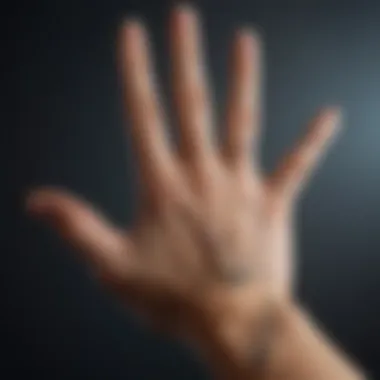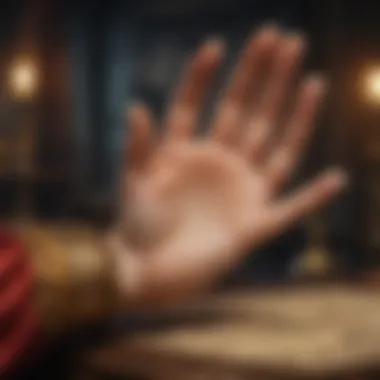The Palmistry Scanner: Merging Technology and Tradition


Intro
The fusion of technology and traditional practices often leads to revealing insights, especially in fields like divination. One such innovation is the palmistry scanner, a tool that bridges the gap between ancient wisdom and modern analysis. This exploration will delve into its significance, utility, and implications in understanding personality traits and life paths through detailed palm analysis.
Understanding the Zodiac
Overview of Zodiac Signs
Palmistry, while focused on interpreting the lines and mounts of the hand, can intersect with astrological concepts. Each zodiac sign brings unique attributes that can enhance the readings provided by palmistry. The twelve zodiac signs; Aries, Taurus, Gemini, Cancer, Leo, Virgo, Libra, Scorpio, Sagittarius, Capricorn, Aquarius, and Pisces, serve as foundational elements in astrology.
Sign Traits and Characteristics
Each sign reveals certain traits:
- Aries: Dynamic and assertive, often first to act.
- Taurus: Grounded and reliable, appreciates stability.
- Gemini: Adaptable and clever, thrives on communication.
- Cancer: Nurturing and intuitive, values home.
- Leo: Charismatic and creative, seeks the spotlight.
- Virgo: Analytical and detail-oriented, tends to be critical.
- Libra: Diplomatic and social, values balance and harmony.
- Scorpio: Intense and secretive, known for depth.
- Sagittarius: Adventurous and optimistic, loves knowledge.
- Capricorn: Disciplined and ambitious, strives for status.
- Aquarius: Innovative and free-spirited, values originality.
- Pisces: Compassionate and imaginative, often artistic.
Elemental Qualities
Additionally, each zodiac sign is linked to one of four elements: Earth, Air, Fire, and Water. Understanding these elemental qualities provides more depth in analyzing characteristics and life paths.
- Earth: Grounded, practical.
- Air: Intellectual, communicative.
- Fire: Passionate, energetic.
- Water: Emotional, intuitive.
Astrological Insights
Current Astrological Trends
The analysis of palmistry can be augmented by examining current astrological trends, such as planetary alignments and transits which may influence an individual's decisions and opportunities.
Influence of Celestial Events
Celestial events like eclipses and retrogrades can also play a role in the readings conducted using palmistry scanners. Such events can signify important times for reflection or change.
How to Interpret Your Birth Chart
Interpreting one's birth chart can provide insights that complement palmistry findings. A birth chart outlines the positions of celestial bodies at the exact moment of birth, offering a frame for understanding personality and behavioral tendencies.
Horoscope and Predictions
Monthly or Weekly Forecasts
Palmistry scanners can be used in conjunction with horoscopes to deliver tailored monthly or weekly forecasts. Such forecasts are grounded in both palm analysis and astrological aspects, giving more nuanced predictions.
Personalized Horoscope Reading
A personalized horoscope reading takes into account both the individual's zodiac sign and their unique palm features, creating a comprehensive overview of personal challenges and possibilities.
Compatibility Readings based on Zodiac signs
Compatibility readings utilizing both zodiac signs and palmistry scans allow individuals to better understand relational dynamics. Such an approach can illuminate potential strengths and weaknesses in interpersonal relationships.


“The integration of modern technology into traditional practices paves the way for deeper insights.”
Intro to Palmistry Scan Technology
Palmistry is an ancient practice that holds significant cultural and spiritual importance. With the emergence of technology, palmistry scan technology aims to bridge the gap between tradition and modernity. This section explores crucial aspects and benefits of the technology, setting the foundation for understanding its relevance in today’s world.
The concept of palmistry, or chiromancy, relies on the interpretation of the shapes and lines on the palm. In this digital age, the introduction of scanners represents a notable shift. The significance lies in how these devices enhance traditional readings, offering more precision and objectivity. This capability can enrich the experience for both practitioners and clients, allowing for deeper insights.
Definition of Palmistry
Palmistry, often referred to as chiromancy, is the art of interpreting the lines, shapes, and features on a person's hands. It is believed to reveal insights about one’s personality and possible future. Each line and mount on the palm corresponds to different aspects of life, such as love, career, and health. The ancient roots can be traced back thousands of years, offering a rich tapestry of cultural significance. Practitioners analyze not just the lines, but also the hand shapes and finger lengths, each offering vital clues about the individual. The practice requires intuitive understanding paired with technical skill.
What is a Palmistry Scanner?
A palmistry scanner is a technological device designed to analyze and interpret the unique features of a person’s palm. Unlike traditional readings, which depend heavily on the reader's expertise, a palmistry scanner captures detailed images of the hand and processes data through algorithms. This method provides standardized interpretations and insights that can be consistent across different users. As a result, the scanner aims to democratize palmistry by making insights more accessible to a wider audience. It represents a fusion of ancient wisdom with contemporary science, highlighting the ongoing evolution of divination practices.
Historical Context of Palmistry
The historical context of palmistry enriches our understanding of its relevance and ongoing application in contemporary society. By examining the origins and evolution of palm reading practices, we can appreciate how cultural and technological shifts have transformed palmistry from an ancient art form into a modern analytical tool. This context is crucial for practitioners and enthusiasts alike, as it reveals the depth of knowledge and significance behind the lines and symbols etched into our palms.
Origins of Palmistry
Palmistry, or chiromancy, traces its roots back to ancient civilizations. The earliest documented references appear in Indian, Chinese, and Egyptian cultures. In India, texts like the Kali Guhya date back over 3,000 years and form the foundation of palmistry principles. Meanwhile, ancient Chinese scholars explored similar concepts in their philosophical texts. Egyptian tombs reveal images of palm reading practices, signifying its importance in assessing fate and personal qualities.
These cultures believed that the hands reflect one's character, emotional state, and even destiny. They viewed palmistry as not merely entertainment, but as a serious attempt to decode human existence based on observable traits. This interrelation between behavior and physical form underscored the belief that our lives are interconnected with cosmic forces.
As these foundational ideas developed, palmistry became integrated with astrology and other esoteric practices, further enhancing its complexity and appeal. Recognizing these origins helps modern practitioners appreciate the foundational beliefs that shape contemporary palmistry techniques.
Evolution of Palm Reading Techniques
Over the centuries, the techniques of palmistry have undergone significant evolution, greatly influenced by cultural exchanges and scientific advancements. From the rigid methodologies in ancient texts to the more fluid interpretations of today, palm reading reflects the society in which it exists.
- Influence of Renaissance Thought: During the Renaissance, a surge of interest in science and reason brought about new interpretations of palmistry. Scholars began documenting observations and classifications, aligning these with astrological forecasts and personality typologies.
- The 19th Century Revival: The 1800s marked a revival in palmistry in Western societies, coinciding with the Spiritualist movement. Figures like Cheiro, an acclaimed palmist, popularized palmistry through books and public demonstrations, making it accessible to a wider audience.
- Integration with Technology: The recent advent of technology has transformed palm reading techniques. Digital applications and palmistry scanners have emerged, merging traditional knowledge with modern analytical methods. These advancements facilitate data collection and interpretation, making palmistry more consistent and reliable.
Understanding the evolution of palm reading techniques allows practitioners to adapt to current trends, ensuring that palmistry remains relevant in a rapidly changing world.
Price of wisdom is vigilance - a reminder for those who pursue the ancient art of palmistry in modern times.
Mechanics of Palmistry Scanners
The mechanics of palmistry scanners play a crucial role in understanding how technology interacts with ancient practices. As these devices become more prevalent, it is essential to grasp their operating principles and components to acknowledge their relevance fully. This section not only elucidates the inner workings of palmistry scanners but also emphasizes the benefits they offer in modern applications while considering potential limitations and ethical implications.
How Palmistry Scanners Operate
Palmistry scanners function by utilizing advanced imaging technology to analyze the unique features of a person's hands. These features include lines, mounts, and shapes that are traditionally interpreted by skilled practitioners. The scanner typically employs high-resolution cameras and specialized software designed to detect and catalog these characteristics.
- Data Capture: The scanner captures detailed images of the palm and fingers, including their contours and distinct line patterns.
- Image Processing: After capturing the images, software processes the data, recognizing and interpreting the various palm features. These algorithms are often based on extensive databases of palm readings to enhance accuracy.
- Analysis Output: The final analysis is presented as a report, often in digital format, summarizing insights concerning personality traits, potential life paths, and compatibility with others.
Technological Components
Understanding the technological components of palmistry scanners is vital for anyone interested in this intersection of technology and tradition. Here are key elements:


- Cameras and Sensors: High-definition cameras capture detailed images, while sensors ensure accurate depth perception and recognition of palm features.
- Software Algorithms: These are essential for analyzing the data collected. They use artificial intelligence to improve accuracy over time as more data is processed.
- User Interface: A design that makes it easy to navigate the scanning process and understand the results. This often includes visual aids to help interpret findings.
The integration of these components provides a seamless experience for the user, turning the complex art of palm reading into a systematic, data-driven process.
Interpreting Scanner Data
Interpreting data from palmistry scanners requires a combination of technical understanding and intuitive insight. The output can include statistical representations, such as percentages, which provide a quantitative assessment of traits. However, the richness of this data lies in its qualitative aspects. Here are some aspects to consider:
- Understanding Output Reports: Users must learn how to read the reports, which often come with explanations about what each characteristic indicates.
- Cross-Referencing with Traditional Knowledge: While the scanner provides insights based on tech, traditional knowledge can enhance interpretation. This combination consolidates the overall understanding of the individual’s palm.
- Limitations of Scanner Data: It is important to acknowledge that while scanners offer a new perspective, they may not capture all nuances that an experienced practitioner could recognize in live readings, such as energy or emotional state.
By comprehensively understanding the mechanics of palmistry scanners, practitioners are better equipped to leverage this technology in their work. As the field evolves, the collaboration between tradition and innovation will likely shape future practices in palmistry.
The Practical Applications of Palmistry Scan Technology
The exploration of palmistry scan technology unveils several useful applications that are gaining traction in modern society. By integrating advanced scanning technology with traditional palm reading, individuals can discover a multifaceted understanding of themselves and their relationships. This section will delve into three significant applications: personal insight and self-discovery, relationship compatibility analysis, and professional guidance.
Personal Insight and Self-Discovery
A primary application of palmistry scanners is the facilitation of personal insight and self-discovery. As people seek effective methods to understand their traits and life paths, palmistry scanners provide a detailed analysis of palm features such as lines, shapes, and mounts. These features can reveal inherent qualities, strengths, and potential challenges.
Many users find that the insights obtained from a palmistry scan can lead to valuable reflections on their behaviors and decisions. Self-awareness is enhanced when individuals see how their palm traits correlate with life experiences. For instance, if a person has a significant heart line, they might be inclined to evaluate their emotional relationships more carefully, leading to conscious changes in how they interact with others.
Ethical Considerations in Using Palmistry Scanners
The rise of palmistry scanners brings forth not only exciting possibilities but also significant ethical considerations. As technology collides with ancient practices, understanding the implications of its use becomes essential. This section will explore privacy implications and misinformation risks associated with palmistry scanners, illuminating the critical issues that practitioners and users must navigate.
Privacy Implications
The integration of palmistry scanners into daily practice can raise privacy concerns for individuals who seek insights into their lives. These scanners often rely on the analysis of personal biometric data, specifically the features of one’s palms. As such, practitioners must ensure they respect the confidentiality of the information collected.
- Data Security: Handling sensitive information mandates a robust approach to data protection. Proper storage and encryption methods must be in place to prevent unauthorized access.
- User Consent: It is vital to obtain consent from any individual seeking analysis. Clarity regarding how their data will be used is crucial not only for ethical practice but also for fostering trust.
- Anonymity: Whenever possible, anonymizing data can alleviate concerns from users who might fear misuse.
In this regard, practitioners need to foster a culture of transparency regarding the working of the palmistry scanner. Users should feel empowered to ask questions and express concerns regarding their data.
Cultural Perspectives on Palmistry
Cultural perspectives on palmistry offer a vital lens through which one can examine the relationships between tradition and modernity in divination practices. This section explores how different cultures perceive and apply palmistry, illustrating its diverse roles across global spiritual landscapes. Understanding these perspectives broadens appreciation for palmistry beyond its esoteric roots, linking it to social, historical, and psychological frameworks. This multifaceted approach enriches the interpretation of palmistry scanners, connecting technological advancements with centuries-old beliefs about personal understanding and destiny.
Global Variations of Palmistry
Palmistry is not a monolithic practice; it varies greatly across cultures. Each tradition infuses its unique beliefs, interpretations, and methods into the art of reading palms. For instance, in Indian palmistry, known as Samudrik Shastra, there is a focus on the physiological, spiritual, and astrological aspects of the palm. Practitioners may analyze the fingers' length, the mounts of the hand, and lines deeply, connecting them to planetary influences.
In contrast, Western palmistry often emphasizes psychological traits linked to the lines and shapes of the hands. The approach is more analytical and less esoteric, potentially aligning with modern psychological theories. Rituals and practices may also differ, as some cultures incorporate palmistry within larger spiritual frameworks, such as astrology or numerology.
Some notable variations include:
- Chinese Palmistry: Integrates elements of Feng Shui and astrology.
- Arab Palmistry: Often intertwined with folklore and storytelling traditions.
- African Palmistry: Can hold community and ancestral importance, linking personal readings with cultural history.
The differences in these practices underscore the adaptability of palmistry, allowing it to persist and evolve in various contexts.
Palmistry in Modern Spiritual Practices


In contemporary times, palmistry finds its relevance enhanced through how it integrates into modern spiritual practices. Many people today are seeking holistic understanding and personal insight. This modern revival often emphasizes self-discovery, aiming to connect the individual with their deeper self and the universe at large.
Key aspects of palmistry in modern spiritual contexts include:
- Holistic Healing: Palmistry can be part of broader healing modalities, including reiki and meditation. Many practitioners use hand readings to facilitate discussions about life paths and well-being.
- Workshops and Community Circles: These gatherings often incorporate palmistry as a tool for personal growth and sharing insights collaboratively.
- Online Platforms: Social media and websites provide spaces for discussions around palmistry, with communities forming around shared interests. This has democratized knowledge, making palmistry accessible to wider audiences.
Emphasizing its role today, palmistry serves as a bridge connecting traditional wisdom with modern spiritual needs. The incorporation of palmistry scanners into this practice allows for a more nuanced and analytical approach, aligning with contemporary preferences for data-driven insights.
The integration of cultural perspectives into palmistry showcases its versatility and resilience, revealing connections to technology and personal narrative.
Future Trends in Palmistry Technology
The relationship between technology and traditional practices such as palmistry is becoming increasingly relevant in an era dominated by innovation. As we explore future trends in palmistry technology, we see a convergence that not only enhances the practice but also broadens its accessibility. The integration of advanced tools like palmistry scanners presents unique opportunities to understand this ancient art form. By examining how technology intersects with palmistry, practitioners can unlock more profound insights into personality and life patterns, and even promote ethical considerations in its applications.
The Growth of AI in Palmistry
Artificial Intelligence is beginning to redefine the landscape of many fields, and palmistry is no exception. The growth of AI brings numerous benefits to palmistry scanners. These tools leverage machine learning algorithms to analyze palm features more thoroughly than human practitioners could alone. As data accumulates from various palm interpretations, the AI can refine its analysis over time, leading to increasingly accurate readings.
AI systems can also aid novice practitioners by providing guided interpretations. This assists them in understanding the nuances of palmistry without the steep learning curve that traditionally accompanies the practice.
Some key aspects of AI's role in palmistry include:
- Data-Driven Insights: AI can analyze vast datasets of palm readings, identifying patterns that would likely go unnoticed by individuals.
- Personalization: Tailored analysis becomes feasible when AI adapts its output to the user's unique palm characteristics.
- Scalability: Automated processes can handle more readings without fatigue or distraction.
These advancements ultimately lead to better-informed practices and allow practitioners to delve deeper into personal insights and future trends.
Integration with Other Divination Tools
Another noteworthy trend is the integration of palmistry scanners with other divination tools. This synergy enhances the manifold dimensions of personalized readings. For example, combining palmistry with astrology or tarot creates a more holistic approach to self-discovery.
Combining different methods presents several advantages:
- Comprehensive Profiles: Users receive a more complete picture of their personalities and potential life paths.
- Cross-Verification: Insights gained from one tool can be validated or contradicted by another, enriching the overall interpretation.
- User Engagement: Engaging with multiple forms of divination increases user interest and encourages further exploration.
By facilitating these integrations, palmistry scanners can provide a richer tapestry of information. This burgeoning trend not only enhances the personal experience but establishes a bridge between modern technology and ancient practices, making palmistry more relevant in the digital age.
The future of palmistry lies at the intersection of tradition and technology, where both can coexist to enrich human understanding.
Ending
In this article, we explored the intricate nature of palmistry scanners, emphasizing their significance in melding traditional practices with modern technology. The conclusion serves as a reflective pause, allowing readers to synthesize the insights gathered throughout the various sections. This topic is not merely about technology; it highlights how these devices can serve as a bridge between ancient wisdom and contemporary interpretation.
Summary of Insights
The exploration of palmistry scanners has revealed several key insights:
- Technological Integration: Palmistry scanners provide advanced tools for interpreting palm features, offering precise measurements and detailed analyses that go beyond subjective human readings.
- Practical Applications: From self-discovery to professional guidance, the applications are diverse and meaningful, making this technology relevant in various aspects of personal and relational understanding.
- Ethical Considerations: Privacy and misinformation must be addressed as the technology evolves, ensuring that practitioners use these tools responsibly.
“Palmistry scanners reflect an intriguing convergence of tradition and innovation, enabling deeper insights into human behavior and compatibility.”
These points underscore the relevance of the palmistry scanner in modern practice. It invites a re-evaluation of how we view traditional arts in light of technological advancement.
The Role of Tradition in Modern Practice
As we draw our discussion to a close, it is essential to acknowledge the role tradition plays in shaping the current landscape of palmistry. While palmistry scanners represent cutting-edge tech, they do not exist in a vacuum. Instead, they complement age-old practices by enhancing the depth of analysis.
- Connection to Ancestral Knowledge: Practicing palmistry has roots in cultural heritage. Many divination enthusiasts hold strong ties to these traditions, which enrich their understanding of personalities and destinies.
- Integration with Modern Techniques: The blend of traditional palm reading with scanner insights can lead to more holistic interpretations. This synthesis respects the historical context while embracing innovation.
- Continuity of Knowledge: As new technologies unfold, they create platforms for younger generations to learn from seasoned practitioners. The scanning technology could potentially preserve and disseminate traditional palmistry knowledge more effectively.







